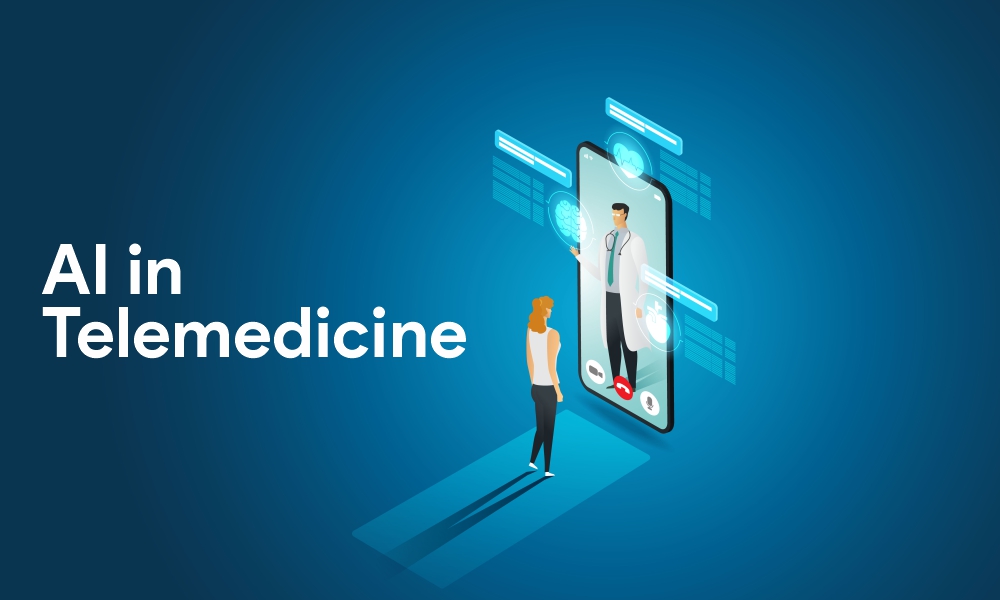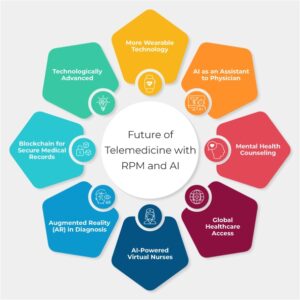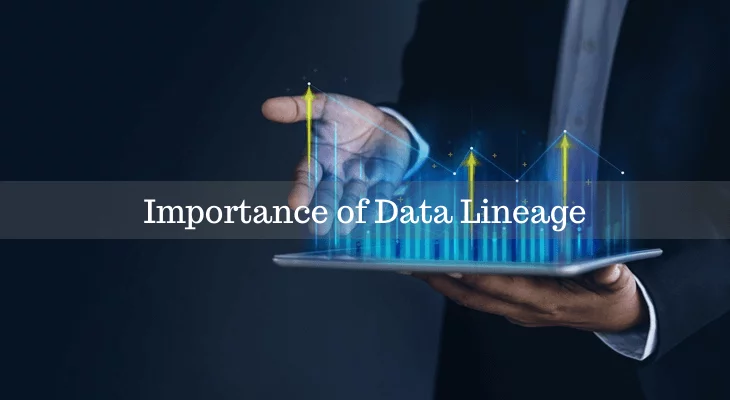Healthcare is changing at a fast pace in today's fast world. Those days are long gone when a visit to the doctor used to involve waiting hours in busy clinics. All thanks to telemedicine AI, where medical consultations are just a click away. It is not limited to making video conferences with physicians but has become smarter with remote patient monitoring (RPM) and artificial intelligence (AI).
These technologies are making health care more accessible, streamlined, and designed according to our needs. In this blog, we'll see how AI and RPM are influencing it and why it is important for patients and physicians.
What Is Telemedicine?
Telemedicine is a clinical service that uses technology to deliver health care services remotely. Rather than going to a hospital, patients can speak to doctors through video conferencing (such as Zoom or dedicated healthcare apps), new appointments, chat-based medical counsel, and remote monitoring devices (wearable devices). This method conserves time is safe and brings healthcare to individuals in rural or underserved communities.
How AI Is Increasing Telemedicine?
Artificial intelligence is making technology even stronger. Here's how:
1. AI-powered diagnostics
AI can process medical information quicker than humans. For instance,
-
- Chatbots & Virtual Assistants: AI chatbots (such as those on hospital websites) can query patients regarding symptoms and recommend whether they should seek urgent attention.
- Image Recognition: AI can analyze X-rays, MRIs, and skin images to diagnose diseases like pneumonia or skin cancer accurately.
- Voice Analysis: Certain Artificial intelligence applications can identify variations in a patient's voice to diagnose conditions such as Parkinson's or depression.
2. Personalized Treatment Plans
AI learns a patient's medical history and genetics as well as lifestyle to suggest personalized treatment. For instance:
-
- A diabetic patient's blood glucose readings can be examined to recommend changing diets.
- AI can identify which drugs would most effectively respond based on a patient's genes.
3. Reducing Doctor’s Visits
Physicians tend to have heavy caseloads. AI assists by averaging:
-
- Making administrative work automatic (scheduling, billing, note-taking).
- Identifying critical cases so that physicians give top priority to crucial patients.
Remote Patient Monitoring (RPM)
Remote Patient Monitoring (RPM) allows doctors to monitor patients' health in real time through connected devices. It is particularly beneficial for chronic diseases such as diabetes, heart disease, and hypertension.
How RPM Works?
Patients wear a monitor device or home devices that send information to healthcare professionals. Examples are:
-
- Smartwatches (Apple Watch, Fitbit): Monitor heart rate, sleep, and activity.
- Glucose Monitors: Transmit blood sugar levels to physicians in real time.
- Blood Pressure Cuffs: Automatically capture and share readings.
- ECG Monitors: Identify abnormal heart rhythms and warn physicians.
Advantages of RPM
Early Identification of Issues: If a patient's blood pressure rises, the physician receives a notification and can react before an emergency occurs.
Reduced Hospital Visits: Chronic patients can skip regular check-ups because physicians keep them under observation remotely.
Improved Patient Involvement: Individuals become more health-conscious when they get to view real-time information.
Cost-Effective Care: Preventing crises prevents hospitalizations, which saves patients and health systems money.
Challenges to AI and RPM in Telemedicine
Although AI and RPM present amazing advantages, there are nonetheless obstacles:
1. Privacy and Security Issues
-
- Medical data is personal. If breached, it can be misused.
- Robust encryption and rigorous rules (such as HIPAA within the United States) are required.
2. Barriers to Technology Access
-
- Not everybody owns a smartphone or has reliable internet, particularly in rural communities.
- Older patients may struggle with using digital tools.
3. AI Errors and Bias
-
- AI works good on the basis of data it is trained on. If the data is biased, diagnoses may be inaccurate.
- Human doctors still need to verify AI suggestions.
4. Regulatory and Legal Issues
-
- Laws around AI in healthcare are still evolving. Who is responsible if an AI misdiagnoses a patient?
The Future of Telemedicine with Remote Patient Monitoring and Artificial Intelligence
The use of AI and remote patient monitoring is only the beginning. The future may hold these advancements:
-
- More Wearable Technology: Gadgets will get smaller, affordable, and more precise.
- AI as an Assistant to Physicians: AI won't act as a substitute for physicians but will help them make quicker, better-informed decisions.
- Mental Health Counseling: AI chatbots will offer therapy and emotional counseling, particularly in regions with limited mental health professionals.
- Global Healthcare Access: Remote villages will get expert consultations via AI-powered telemedicine.
- AI-Powered Virtual Nurses: Virtual assistants and chatbots offer simple medical advice and medication reminders.
- Augmented Reality (AR) in Diagnosis: Physicians could utilize AR glasses to evaluate patients remotely more interactively.
- Blockchain for Secure Medical Records: Decentralized systems can enable secure sharing of medical data and enhanced transparency.
- Technologically advanced: Telemedicine will be even more user-friendly, making healthcare more efficient, cost-effective, and accessible to all.
Final Thoughts!
Telemedicine, powered by AI and remote patient monitoring, is not just a trend; it is the future of healthcare. It is making medical care faster, more personalized, and accessible to millions. While challenges remain, the benefits far outweigh the risks.
As technology advances, we’ll see even smarter healthcare solutions - ones that prevent diseases before they become serious and keep patients healthier for longer.
The future of medicine isn't in hospitals, it is in our homes, on our wrists, on our fingertips. Embrace the future of healthcare with telemedicine.
Want to keep up with tech blogs? We have got all the topics you need at KnowledgeNile!
FAQs
1. How does AI enhance remote patient monitoring?
Answer: AI inspects information from wearable sensors. It identifies irregularities and alerts physicians in real time. This prevents emergencies and improves treatment accuracy.
2. Is telemedicine as effective as visiting doctors in person?
Answer: Yes, for most conditions. Telemedicine is beneficial for follow-ups, chronic disease care, and minor sicknesses. Though, critical situations may still require physical checks.
3. Are telemedicine services costly?
Answer: No, telemedicine typically saves costs by reducing hospital stays. Most insurance plans now cover online consultations, so it is an inexpensive alternative.
Recommended For You:






